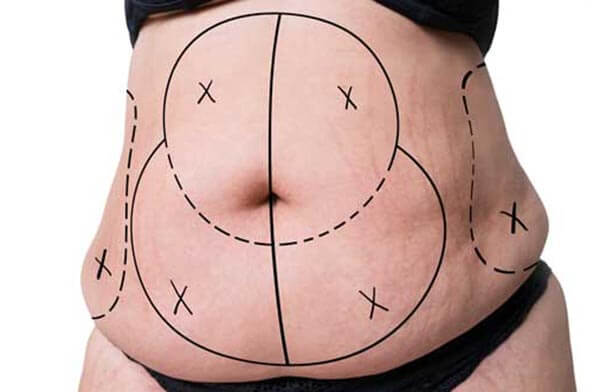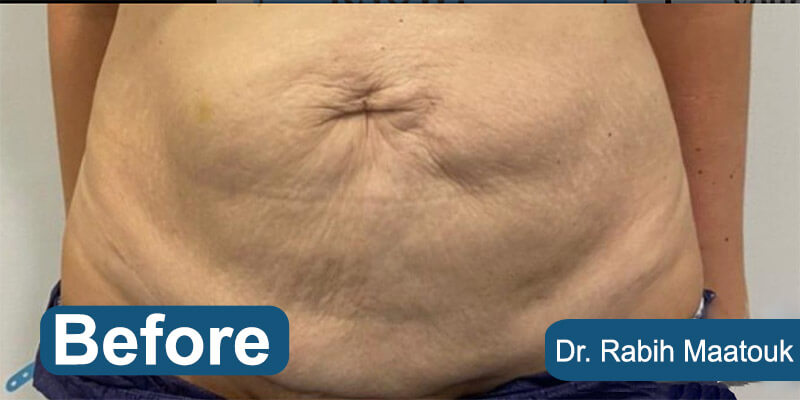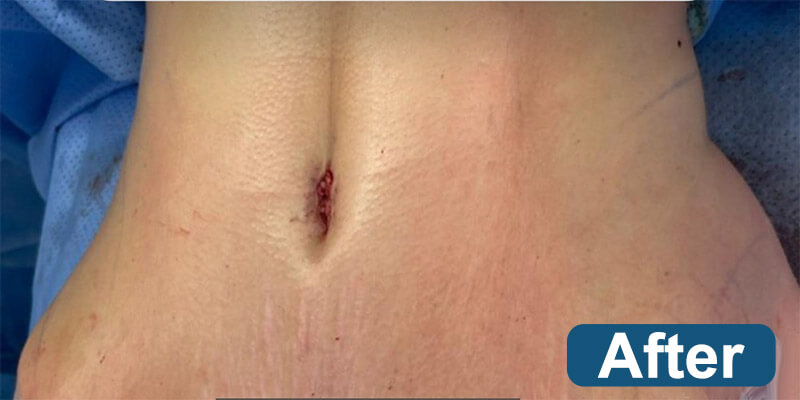Harley Street Medical Centre, Abu Dhabi
050 701 3711
02 613 3808
info@drrabihmaatouk.com
info@hsmc.ae
A tummy tuck (abdominoplasty) is a surgical procedure that removes excess skin and fat from the abdominal area while tightening the underlying muscles. This procedure can help to achieve a flatter, more toned appearance to the abdomen.

There are several types of tummy tuck procedures available, each designed to address different concerns and achieve different results. Some common types of tummy tuck procedures include:
Traditional Tummy Tuck: This is the most common type of tummy tuck procedure, which involves making a horizontal incision between the hips and a vertical incision around the belly button. The surgeon will remove excess skin and fat, tighten the abdominal muscles, and reposition the belly button for a smoother, flatter appearance.
Mini Tummy Tuck: This procedure is similar to a traditional tummy tuck but is designed to address a smaller area of concern. It involves making a smaller incision and removing a smaller amount of skin and fat. The belly button may or may not need to be repositioned during this procedure.
Extended Tummy Tuck: This procedure is similar to a traditional tummy tuck but involves making a longer incision to remove excess skin and fat from the abdomen and flanks (love handles) area. This procedure is typically recommended for patients who have lost a significant amount of weight and have excess skin in the lower abdomen and back.
Circumferential Tummy Tuck: This is the most extensive type of tummy tuck procedure, which involves making a horizontal incision around the entire waistline to remove excess skin and fat from the abdomen, hips, and back. This procedure is typically recommended for patients who have lost a significant amount of weight and have excess skin and fat in multiple areas of the body.
The best candidates for a tummy tuck are individuals who:
Before the surgery, the patient will have a consultation with the surgeon to discuss their goals and determine the best approach for their individual needs. The surgeon will perform a physical examination and may also order imaging studies to determine the extent of the abdominal muscle separation and the location of excess fat and skin.
During the surgery, the surgeon will make an incision along the lower abdomen and remove excess skin and fat while tightening the underlying muscles. The length of the incision will depend on the extent of the procedure and the amount of excess skin to be removed.
After the surgery, patients can go back to work within two to six weeks. The amount of recovery time needed depend on several factors of surgery. Patients should avoid strenuous activities and heavy lifting for several weeks and wear a compression garment to aid in the healing process.
The results of a tummy tuck can provide a significant improvement in the appearance of the abdomen, resulting in a flatter, more toned appearance. The results are typically long-lasting, but it is important to maintain a healthy lifestyle and avoid significant weight fluctuations to preserve the results.
As with any surgery, there will be some scarring along the incision line, but the surgeon will work to make the incision as discreet as possible. The extent of scarring will depend on the individual's skin type and the extent of the procedure.
There are several types of tummy tuck procedures available, each designed to address different concerns and achieve different results. Some common types of tummy tuck procedures include:
Traditional Tummy Tuck: This is the most common type of tummy tuck procedure, which involves making a horizontal incision between the hips and a vertical incision around the belly button. The surgeon will remove excess skin and fat, tighten the abdominal muscles, and reposition the belly button for a smoother, flatter appearance.
Mini Tummy Tuck: This procedure is similar to a traditional tummy tuck but is designed to address a smaller area of concern. It involves making a smaller incision and removing a smaller amount of skin and fat. The belly button may or may not need to be repositioned during this procedure.
Extended Tummy Tuck: This procedure is similar to a traditional tummy tuck but involves making a longer incision to remove excess skin and fat from the abdomen and flanks (love handles) area. This procedure is typically recommended for patients who have lost a significant amount of weight and have excess skin in the lower abdomen and back.
Circumferential Tummy Tuck: This is the most extensive type of tummy tuck procedure, which involves making a horizontal incision around the entire waistline to remove excess skin and fat from the abdomen, hips, and back. This procedure is typically recommended for patients who have lost a significant amount of weight and have excess skin and fat in multiple areas of the body.
The best candidates for a tummy tuck are individuals who:
Before the surgery, the patient will have a consultation with the surgeon to discuss their goals and determine the best approach for their individual needs. The surgeon will perform a physical examination and may also order imaging studies to determine the extent of the abdominal muscle separation and the location of excess fat and skin.
During the surgery, the surgeon will make an incision along the lower abdomen and remove excess skin and fat while tightening the underlying muscles. The length of the incision will depend on the extent of the procedure and the amount of excess skin to be removed.
After the surgery, patients can go back to work within two to six weeks. The amount of recovery time needed depend on several factors of surgery. Patients should avoid strenuous activities and heavy lifting for several weeks and wear a compression garment to aid in the healing process.
The results of a tummy tuck can provide a significant improvement in the appearance of the abdomen, resulting in a flatter, more toned appearance. The results are typically long-lasting, but it is important to maintain a healthy lifestyle and avoid significant weight fluctuations to preserve the results.
As with any surgery, there will be some scarring along the incision line, but the surgeon will work to make the incision as discreet as possible. The extent of scarring will depend on the individual's skin type and the extent of the procedure.


